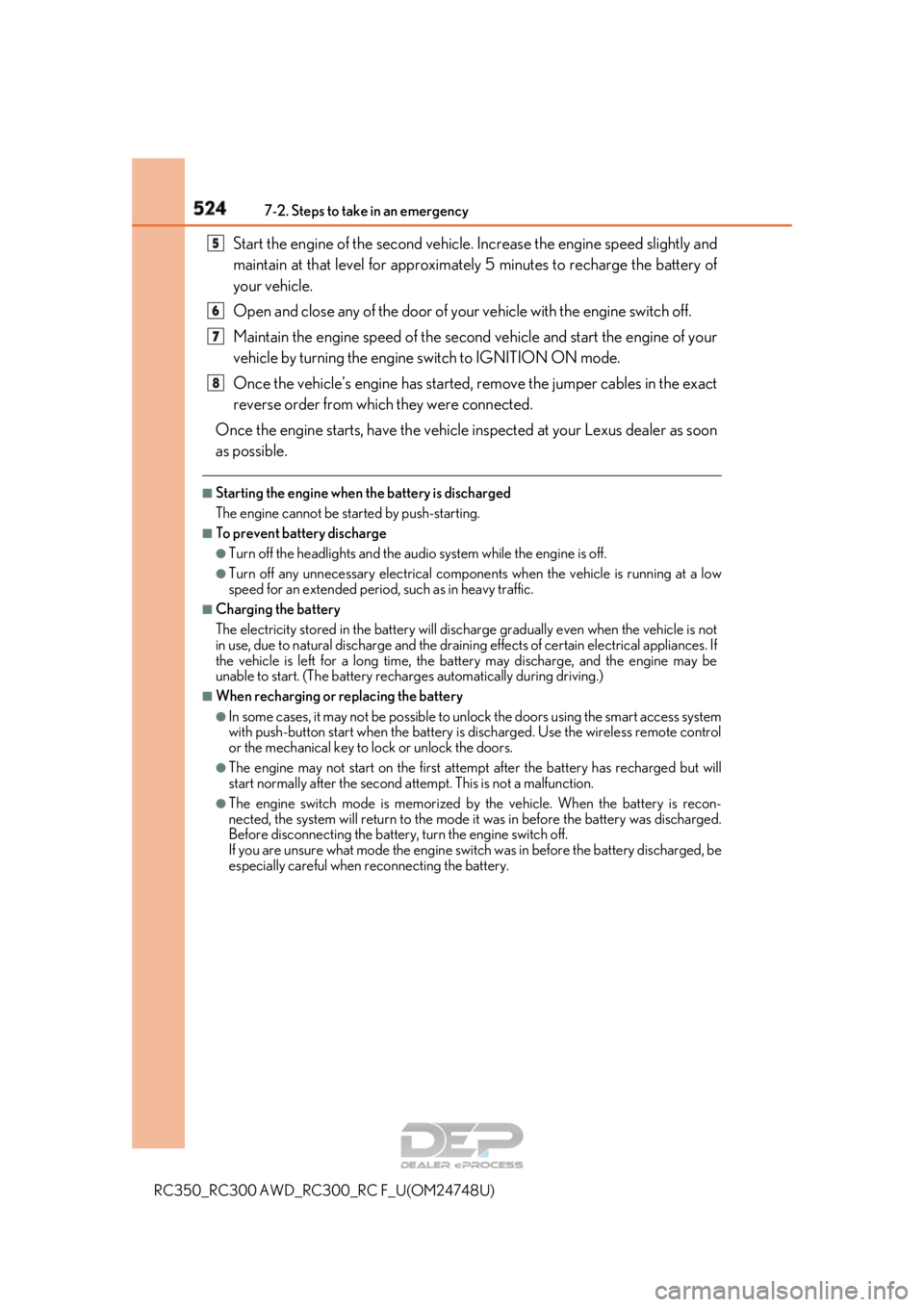Page 524 of 636

5247-2. Steps to take in an emergency
RC350_RC300 AWD_RC300_RC F_U(OM24748U)
Start the engine of the second vehicle. Increase the engine speed slightly and
maintain at that level for approximatel y 5 minutes to recharge the battery of
your vehicle.
Open and close any of the door of your vehicle with the engine switch off.
Maintain the engine speed of the second vehicle and start the engine of your
vehicle by turning the engine switch to IGNITION ON mode.
Once the vehicle’s engine has started, remove the jumper cables in the exact
reverse order from which they were connected.
Once the engine starts, have the vehicle inspected at your Lexus dealer as soon
as possible.
■Starting the engine when the battery is discharged
The engine cannot be started by push-starting.
■To prevent battery discharge
●Turn off the headlights and the audio system while the engine is off.
●Turn off any unnecessary electrical components when the vehicle is running at a low
speed for an extended period , such as in heavy traffic.
■Charging the battery
The electricity stored in the battery will disc harge gradually even when the vehicle is not
in use, due to natural discharge and the draini ng effects of certain electrical appliances. If
the vehicle is left for a long time, the battery may discharge, and the engine may be
unable to start. (The battery recharges automatically during driving.)
■When recharging or replacing the battery
●In some cases, it may not be possible to un lock the doors using the smart access system
with push-button start when the battery is discharged. Use the wireless remote control
or the mechanical key to lock or unlock the doors.
●The engine may not start on the first attempt after the battery has recharged but will
start normally after the second attempt. This is not a malfunction.
●The engine switch mode is memorized by the vehicle. When the battery is recon-
nected, the system will return to the mode it was in before the battery was discharged.
Before disconnecting the battery, turn the engine switch off.
If you are unsure what mode the engine switch was in before the battery discharged, be
especially careful when reconnecting the battery.
5
6
7
8
Page 545 of 636

5458-1. Specifications
8
Vehicle specifications
RC350_RC300 AWD_RC300_RC F_U(OM24748U)
*: The fluid capacity is a reference quantity.
If replacement is necessary, contact your Lexus dealer.
Electrical system
Battery
Open voltage at 68 F
(20 C):12.3 V or higher
If the voltage is lower than the standard value, charge
the battery.
(Voltage is checked 20 minutes after the engine and all
lights are turned off.)
Charging rates5 A max.
Automatic transmission
Fluid capacity*
RC35010.0 qt. (9.5 L, 8.4 Imp. qt.)
RC350AWD/RC300
AWD10.6 qt. (10.0 L, 8.8 Imp. qt.)
RC3009.2 qt. (8.7 L, 7.7 Imp. qt.)
RC F11.8 qt. (11.2 L, 9.9 Imp. qt.)
Fluid typeToyota Genuine ATF WS
NOTICE
■Automatic transmission fluid type
Using transmission fluid other than “Toyota Genuine ATF WS” may cause deterioration
in shift quality, locking up of your transm ission accompanied by vibration, and ulti-
mately damage the transmission of your vehicle.
Front differential (AWD models)
Oil capacity 0.74 qt. (0.70 L, 0.61 Imp. qt.)
Oil type and viscosityHypoid gear oil API GL-5
Above 0F (-18 C): SAE90
Below 0 F (-18 C): SAE80W or SAE80W-90
Page 634 of 636

634Alphabetical index
RC350_RC300 AWD_RC300_RC F_U(OM24748U)
Units ......................................................111, 129
Vanity lights............................................. 354
Wattage ................................................. 553
Vanity mirrors ........................................ 354
Variable Gear Ratio Steering (VGRS) ...................................................312
Warning message ............................ 460
VDIM (Vehicle Dynamics Integrated Manag ement) ................313
Vehicle data recordings .......................... 9
Vehicle Dynamics Integrated Management (VDIM) .......................313
Vehicle identification number ......... 537
Vehicle Stability Control (VSC) .......................................................312
Ventilators (seat ventilators)............ 346
VGRS (Variable Gear Ratio Steering) .................................................312 Warning message ............................ 460
VSC (Vehicle Stability Control) ..............312 Warning buzzers
Approach warning ........................... 275
Brake system ....................................... 462
Downshifting ..........................................218
Intuitive parking assist......................280
Key reminder .......................................485
LDA (Lane Departure Alert with steering control) ................... 469
Open door ........................................... 454
Open hood........................................... 463
Open moon roof ............................... 473
Open trunk ........................................... 463
Open window ..................................... 473
Pre-collision braking.......................... 251
Seat belt reminder.............................455
Warning lights .......................................... 86 ABS .......................................................... 453
Automatic headlight leveling system .................................................. 454
Brake system ....................................... 453
Charging system ............................... 453
Electric power steering .................. 454
Low fuel level .......................................455
LDA indicator...................................... 454
Malfunction indicator lamp........... 453
Master warning light ........................455
Open door ........................................... 454
Parking brake warning light ......... 454
Pre-collision system ......................... 454
Seat belt reminder light ..................455
Slip indicator ........................................ 454
SRS............................................................ 453
Tire pressure ........................................455
Warning messages.............................. 460
U
V
W